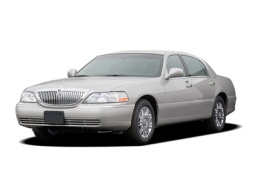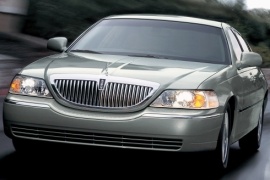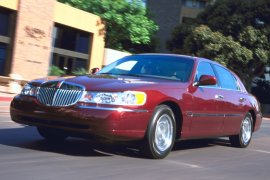LINCOLN Town Car Models/Series Timeline, Specifications & Photos
First production year: 1998
Engines: Gasoline
The Town Car was one of the last full-size American luxury cars, recognized for its smooth rides, reliability, and image.
The third generation of the Town Car was launched at the 1997 New York International Auto Show. It was the preferred base for the stretch-limos from most of the custom-car makers in the U.S. The Lincoln Town Car was the first car in history to receive the government's highest five-star government safety ratings four years in a row for all five categories – including rollover resistance. In 2008, Ford moved the Town Car's production lines into Canada to keep the car at a competitive price on the market, due to the world financial crisis.
Its distinguished design, with the chromed "waterfall" grille and quad headlights, was an imposing presence in Manhattan or any other business area. Its rounded edges were inspired by the Lincoln Mark VIII and the Continental. A barely raked windshield and a tall cabin were needed to offer a vast interior room. At the back, the almost vertically mounted rear window and the thick D-pillars offered both privacy and protection for the rear passengers.
Inside, the Town Car featured a luxurious cabin with ample legroom for all the passengers. There were two wide seats at the front and a wide bench in the rear, with an ample center armrest between the outboard seats. The thick windows and sound-deadening materials ensured a library-like quietness for its passengers. As one of the most important premium American carmakers, Lincoln used only top quality materials inside the limousine.
In 2007, Lincoln offered the car fitted with a refreshed 4.6-liter V8 engine that produced 239 hp. It was paired as standard to a 4-speed, heavy-duty, automatic transmission.
Lincoln introduced a much-deserved facelift for its vehicle's flagship, the Town Car, in 2003, and it showed a touch of modernism over a classic-looking executive car.
Ford decided that Lincoln had to do something with the Town Car to get new, younger customers in its showrooms. It was obvious that the former shapes didn't attract them and, from the technological point of view, it was outdated.
First of all, the front fascia was completely redesigned and included wrapped-around headlights. The grille was smaller, and it looked like a shield with vertical chromed slats. The aerodynamically profiled front bumper added a final touch of modernism. Someone was not ready to give up the fridge-like chromed door handles and kept them in place on the sides. In the rear, the carmaker installed new taillights and reduced the license plate area's size, which was flanked on the sides by the reversing lights. Another important novelty was the button-operated trunk release from the driver's seat.
Inside, it was a significant improvement. Its leather, vented, and heated seats offered plenty of space for five adults. Lincoln even added an option for six, with a 40-20-40 bench at the front. When the middle seat was not in use, an armrest with a storage box took its place. There was even a mobile phone connection, activated via a lever next to the steering wheel. Lincoln engineers and designers moved the buttons for the electrically operated seats on the door panels.
Under the hood, the Town Car relied on the well-known 4.6-liter V-8 built by Ford, and Lincoln paired it to a standard 4-speed automatic gearbox.
Lincoln introduced the third generation of its flagship model, the Town Car, in 1998 and showed a different approach to the market and a change of its targeted customers.
While the first two generations of the Town Car were addressed to those who did business with a cigar on a hand and a glass of wine on the other, Lincoln built the third generation for those who were more attracted to new technologies and indulged themselves with a glass of champagne and went more to the club than to the country club. It built it for the younger generations of entrepreneurs who were more attracted by technologies.
From the outside, the tall, vertical grille was gone, and a chromed, shield-like one took its place. It was slightly raked and showed a modern styling. Its wrapped-around headlights and aerodynamically profiled bumper with horizontal slats at the bottom completed the front fascia. The Town Car kept the cab-rearward concept with a long hood and a thick and vertical C-pillar from its sides. Only the rear windscreen was curved and raked forward.
Inside, the designers kept the straight lines and 90 degrees corner only for the dash's air-vents. The rest of it showed rounded corners and edges, plus an elegant oval clock in the middle. Wood-trims and leather were extensively used on the door panels and most of the interior. There was plenty of legroom in the back, and, as an option, the carmaker installed a mini-bar in the rear armrest.
Under the hood, Ford provided a 4.6-liter engine for its luxury brand and offered it three power outputs between 203 and 238 hp.


